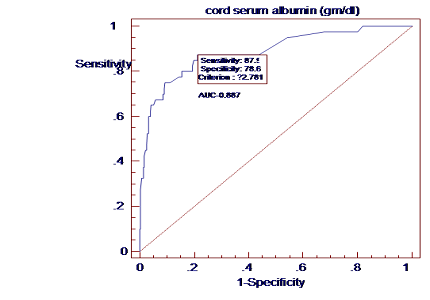Cord serum albumin as a predictor of neonatal hyper bilirubinemia in healthy full-term neonates
Abstract
Introduction: Neonatal jaundice or icterus neonatorum is one of the common problem that is seen in newborns during first week of neonatal life. Clinical jaundice is found in about 80% of preterm and in about 60-70% of term neonates. The main objective of the study was to determine the correlation between cord serum albumin levels and development of significant hyper bilirubinemia in healthy term neonates.
Methods: A prospective study was conducted on 316 healthy term neonates. Gender, mode of delivery and birth weight were taken into consideration. It was ascertained that there was no other risk factor for neonatal hyperbilirubinemia among these newborns. These neonates were divided into 3 groups, Group A (cord serum albumin levels < 2.8 gm/dl), Group B (cord serum albumin levels between 2.8 to 3.4 gm/dl) and Group C (cord serum albumin levels 3.4 gm/dl).
Result: Of the 316 babies included in the study, 102 babies were under Group A, 166 babies under Group B and 48 babies under Group C. 35 babies in Group A, 5 in Group B and none in Group C developed significant hyperbilirubinemia and required phototherapy. The sensitivity and specificity of cord serum albumin level 2.8 g/dl to predict risk of development of significant neonatal hyperbilirubinemia in our study was 87.50% and 75.72% respectively.
Conclusion: Cord serum albumin levels can help us to predict the possibility of significant hyperbilirubinemia among neonates. Hence this can help us to identify the at-risk neonates and utilize our limited resources efficiently among these newborns.
Downloads
References
2. Sahu S, Abraham R, John J, Ann A, Sam A. Cord blood albumin as a predictor of neonatal jaundice. Int J Bio Med Res. 2011; 1(2):436-8.
3. Reshad M, Ravichander B, Raghuraman TS. A study of cord blood albumin as a predictor of significant neonatal hyper bilirubinemia in term and preterm neonates. Int J Res Med Sci. 2016; 4(3):887-90.
4. Neonatal morbidity and mortality: report of the National Neonatal-Perinatal Database. Indian Pediatr. 1997 Nov; 34 (11):1039-42. [PubMed]
5. American Academy of Pediatrics Subcommittee on Hyperbilirubinemia. Management of hyperbilirubinemia in the newborn infant 35 or more weeks of gestation. Pediatrics. 2004 Jul;114(1):297-316. [PubMed]
6. Pasha YZ, Pour MA, Firouzjahi AR, Dehvari A, Baleghi M, Jahangir T.Umbilical Cord Bilirubin Level as a Predictive Indicator of Neonatal Jaundice. J Babol Univ Med Sci. 2015; 17(9):14-8.
7. Venkatamurthy M, Murali S, Hemachandra K. Evaluation of cord serum albumin level as a risk indicator in predicting neonatal Jaundice. Int J Health Info Med Res. 2014;1(2):9-11.
8. Raj RR and Sarangi GD. Cord serum albumin as a tool to predict neonatal hyperbilirubinemia. Index Copernicus International. 2016; 5(3): 131-36.
9. Kumar S, Manjunath G A, Ajay J, Reddy S. Low Cord Serum Albumin is A Risk Indicator in Predicting Neonatal Jaundice. IOSR Journal of Dental and Medical Sciences. 2016; 15(10):76-8. (IOSR-JDMS) e-ISSN: 2279-0853, p-ISSN: 2279-0861.
10. Taksande A, Vilhekar K, Jain M, Zade P, Atkari S, et al. (2005) Prediction of the development of neonatal hyperbilirubinemia by increased umbilical cord blood bilirubin. Ind Medica 9(1): 5-9.
11. Satrya R, Effendi SH, Gurnida DA. Correlation between cord blood bilirubin level and incidence of hyperbilirubinemia in term newborns. PaediatricaIndonesiana. 2009; 49(6):349-54.
12. Maisels MJ, Kring E.Length of stay, jaundice, and hospital readmission. Pediatrics. 1998 Jun;101(6):995-8. [PubMed]
13. Dwarampudi GS and Ramakrishna N. Cord Blood Albumin and Bilirubin Levels As Predictors In Neonatal Hyperbilirubinemia. Int J Pharm Bio Sci 2015 July ;6(3): (B) 273 – 279.
14. Knudsen A. Prediction of the development of neonatal jaundice by increased umbilical cord blood bilirubin. Acta Paediatr Scand. 1989 Mar;78(2):217-21. [PubMed]
15. Awasthi S, Rehman H. Early prediction of neonatal hyperbilirubinemia. Indian J Pediatr. 1998 Jan-Feb;65(1):131-9.
16. Rajpurohit N, Kumar S, Sharma D, Choudhary M, Purohit S. To Assess Predictive Value of Cord Blood Bilirubin and Albumin for Significant Neonatal Hyperbilirubinemia: A Prospective Study from India. J Pediatr Neonatal Care 2(1): 00060. DOI: 10.15406/jpnc.2015.02.00060.
17. Gupta S, Gupta VK, Bhatnagar JP, Agrawal P, Agarwal A, Bhatia S et al. Neonatal hyperbilirubinaemia after induction of labour with oxytocin and cord serum albumin is compared with cord serum bilirubin as a risk indicator. International Journal of Biomedical Research 2016; 7(7): 435-8. DOI:10.7439/ijbr ISSN: 0976-9633; 2455-0566.
18. Aiyappa GKC, Shriyan A, Raj B. Cord blood albumin as a predictor of neonatal hyperbilirubinemia in healthy neonates. Int J Contemp Pediatr2017;4:503-6.

Copyright (c) 2018 Author (s). Published by Siddharth Health Research and Social Welfare Society

This work is licensed under a Creative Commons Attribution 4.0 International License.


 OAI - Open Archives Initiative
OAI - Open Archives Initiative


